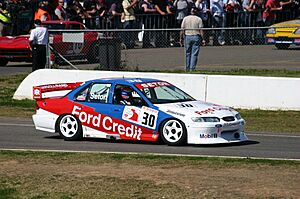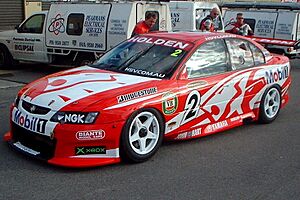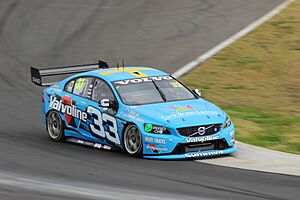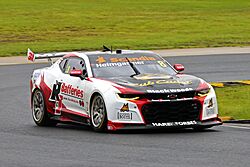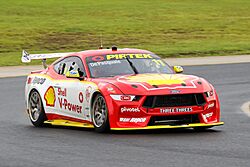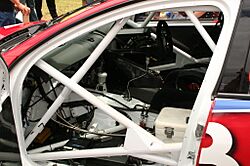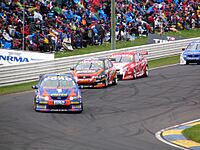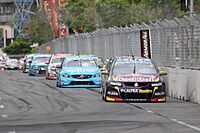Supercars Championship facts for kids
 |
|
| Category | Touring car racing |
|---|---|
| Country | |
| Inaugural season | 1997 |
| Drivers | 25 |
| Teams | 11 |
| Constructors | Chevrolet • Ford |
| Tyre suppliers | Dunlop |
| Drivers' champion | |
| Makes' champion | |
| Teams' champion | |
| Official website | www.supercars.com |
The Supercars Championship, also known as the Repco Supercars Championship, is a thrilling car racing series. It takes place in Australia and New Zealand. This series is an International Series, following rules set by the Fédération Internationale de l'Automobile (FIA).
Supercars races happen in all Australian states and the Northern Territory. There is usually an international race in New Zealand. In the past, races were held in China, Bahrain, the United Arab Emirates, and the United States. A Supercars event also supports the Australian Grand Prix in Melbourne.
Race formats change for each event. Some are sprint races, others are street races. There are also long endurance races at Sandown and Bathurst. These races can last for many hours and involve two drivers per car. Supercars races are shown in 137 countries. Over 100,000 people usually attend each event. The Adelaide 500 is the most popular race in Australia, with over 250,000 fans attending each year.
The cars in the series look a bit like regular road cars. However, they are custom-built race cars. They use a special control chassis, meaning many parts are the same for all cars. Only some body panels are shared with road cars. The cars are designed for "technical parity." This means all teams and drivers have a fair chance to win, no matter which car model they use.
All cars currently use powerful 5.4-liter or 5.7-liter V8 engines. For a long time, only Ford Falcons and Holden Commodores raced. But new rules in 2013 allowed more car makers to join. Nissan was the first new brand, followed by Mercedes-Benz and Volvo. The series returned to just Ford and Holden cars in 2020. Ford replaced the Falcon with the Mustang in 2019. Holden stopped racing in 2022. The Chevrolet Camaro ZL1 took its place for the 2023 season. Starting in 2026, Toyota will join the championship with its GR Supra car.
Contents
History of Supercars
Early Days: Group 3A
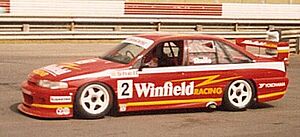
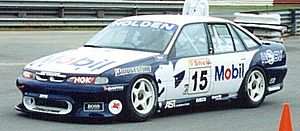
The idea for a racing series focused on V8-engined Fords and Holdens started in 1991. New rules were planned for 1993. Both Ford and Holden wanted to know the details quickly. The main racing body, CAMS, was waiting to see what international rules the FIA would set.
The new rules for the Australian Touring Car Championship (ATCC) were announced in November 1991. They said V8 cars would be much faster than smaller-engined cars. In 1992, CAMS tried to make the cars more equal. But Ford and Holden protested. They did not want smaller cars to beat their V8s. In June 1992, the car classes were confirmed:
- Class A: Australian-made 5.0-liter V8 Fords and Holdens.
- Class B: 2.0-liter cars following FIA rules.
- Class C: Other two-wheel drive cars, only allowed in 1993.
Both the Ford Falcon EB and Holden Commodore VP used American-based engines. These engines had limits on their speed and power. Holden teams could use their own 5.0-liter V8 engine. But from 1994, only smaller private teams could use it. The main Holden teams had to use the more expensive Chevrolet engine.
The V8 cars first raced in the long endurance events in 1992. Their unique aerodynamic design, with large front and rear spoilers, helped them compete. This design aimed to help them beat the powerful Nissan Skyline GT-Rs in those races.
The new rules meant that cars like the turbocharged Nissan Skyline GT-R and Ford Sierra RS500 were not allowed in 1993. Cars like the BMW M3 were allowed. But the M3 had fewer special rules and was heavier. So, BMW focused on the 2.0-liter class for 1994.
Cars from all three classes raced in the 1993 Australian Touring Car Championship. But for points, cars were split into two groups: over 2,000 cc and under 2,000 cc. At first, the 2.0-liter cars raced separately. This changed in 1993 because there were too few 2.0-liter cars.
The new rules aimed for "parity," meaning cars should be equal. But Holden teams protested that Fords had an advantage. Fords won the first three races easily. After five races, Holden was given new front and rear wing parts. BMWs also got new parts. Differences between Fords and Holdens were a big topic for years. Various changes were made to try and make the cars equal.
From 1995, the 2.0-liter cars raced in their own series. They were no longer part of the Australian Touring Car Championship. This meant only 5.0-liter Ford and Holden cars raced in the endurance events at Sandown and Bathurst.
The V8 Supercars Era
In November 1996, a new company called AVESCO was formed to run the series. This helped the series grow a lot in the following years. The racing category also changed its name to 'V8 Supercars'. The cars themselves stayed mostly the same. A new TV deal was made with Network Ten and Fox Sports.
In 1997, Tony Cochrane and James Erskine left IMG. They formed Sports and Entertainment Limited (SEL). TEGA owned 75% of AVESCO, and SEL owned 25%. TEGA managed the rules and cars. SEL handled TV rights, sponsors, and events.
The series started to expand in 1998. The first race in the Northern Territory was held at Hidden Valley Raceway. In 1999, a new street race in Adelaide became a big festival-style event. This type of event became common later. Australia's capital, Canberra, hosted its first race in 2000. In 2001, a championship race was held in New Zealand for the first time. In 2002, the V8 Supercar race at the Indy 300 became a championship event.
Big changes were made in 1999. The long endurance races became part of the championship. All teams started using the same brand of tires, with Bridgestone chosen first. The series name also changed from "Australian Touring Car Championship" to the "Shell Championship Series" because of Shell's sponsorship.
Reverse-grid races were tried in 2000. In these races, the fastest qualifiers started at the back. They were later only used at the Canberra race in 2001. Also in 2001, mandatory pit stops were introduced. The "Top Ten Shootout" was used at all races. In 2002, Dunlop became the new tire supplier. The series name changed again to the "V8 Supercar Championship Series" after Shell stopped sponsoring.
Project Blueprint
Talk about car equality came back in 2000. Holden cars had been very dominant in 1998 and 1999. So, their front spoiler was made smaller. This was done after the Ford Falcon's spoiler had been trimmed in earlier seasons. Ford had even threatened to leave the series. After Holden dominated again in 2001 and 2002, new rules called "Project Blueprint" were introduced in 2003. These rules aimed to make the Ford and Holden cars perform more equally. This led to closer and fairer racing. Project Blueprint was designed over two years to remove most differences between the cars.
Project Blueprint made many parts common for both manufacturers. This included the chassis, wheelbase, and driving position. Holden cars now had to use double-wishbone front suspension, like the Falcon. They also got a Watts link at the back. The car designs were tested and changed to be more equal. Engine differences were also removed. The new Ford BA Falcon and Holden VY and VZ Commodores were very evenly matched for the next four years. Ford won the championship in 2003, 2004, and 2005. Holden won in 2006. Reverse-grid races were used again in 2006 but were stopped halfway through the season because drivers, teams, and fans did not like them.
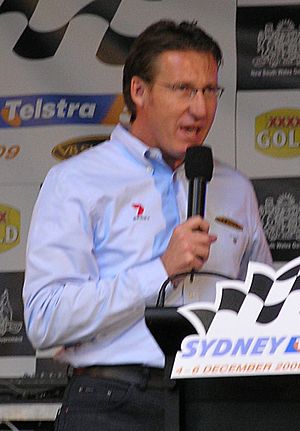
The Holden VE Commodore caused some debate when it arrived in 2007. The road car was bigger than the Ford BF Falcon. This meant the VE race car needed special bodywork to fit the rules. Despite this, the VE was approved after many tests. Sequential gearboxes became mandatory in 2008. In 2009, E85 fuel (85% ethanol) was introduced to make the sport more environmentally friendly. Carbon dioxide emissions dropped by up to 50%. However, cars used 30% more fuel to make the same power. Also in 2009, softer tires were introduced at some events. This aimed to make racing better and allow for different race strategies.
In 2005, AVESCO changed its name to V8 Supercars Australia (VESA). The series continued to grow. Races were held outside Australia and New Zealand for the first time. The series raced in China in 2005, but only for one year. In 2006, the series went to the Middle East, racing in Bahrain. New street circuits appeared in 2008 and 2009 in New Zealand, Townsville, and Sydney. The Middle East expansion continued in 2010 with a race in Abu Dhabi. In November 2010, the series became an international series by the FIA for the 2011 season. This allowed up to six international races each year. So, the series name changed to the 'International V8 Supercars Championship'.
In 2008, the separate boards of VESA and TEGA merged into one. This new board managed the category. In 2011, TEGA and SEL sold shares to Australian Motor Racing Partners (AMRP). This meant SEL lost its share. Archer Capital took a 60% share, and TEGA kept 40%. A new board was set up. In 2011, Archer Capital bought a 65% share. The teams owned the other 35%. In December 2021, both Archer Capital and the teams sold their shares to Race Australia Consolidated Enterprises.
New Generation V8 Supercar
In 2008, a project led by Mark Skaife started to plan for the future of the sport. The main goal was to cut costs to $250,000 per car. This would be done by using common parts. It also aimed to make it easier for new car makers to join. They just needed a four-door sedan that was mass-produced. The new car design, called "Car of the Future," was planned for 2012.
The plan was shown to the public in March 2010. It included big changes to the car's inside parts. The chassis, cooling, fuel, and electronics systems would all use common parts. There would also be changes to the engine, gearbox, rear suspension, wheels, and brakes. Car safety was also improved. Teams liked the plans. However, Holden Motorsport warned new car makers that they would "gain nothing" from joining.
Big changes included switching from a solid rear axle to independent rear suspension. Cars would use a rear gearbox instead of one in the middle. The fuel tank moved to the front of the rear axle for safety. The windscreen changed to a polycarbonate material. Wheels changed from 17 inches to 18 inches. In 2011, it was announced that the Car of the Future would not arrive until 2013.
In February 2012, Nissan confirmed they would join the series with Kelly Racing. Later in 2012, Erebus Motorsport announced they would race Mercedes-Benz cars. In June 2013, Volvo said it would enter in 2014. This was a partnership with Polestar Racing and Garry Rogers Motorsport. In November 2013, the "Car of the Future" name was changed to "New Generation V8 Supercar."
The series kept expanding internationally in 2013. The first race in North America was held in Austin, Texas. In 2015, five drivers did demonstration races in Kuala Lumpur. This was meant to lead to a championship event there in 2016. But the event was canceled due to legal problems.
Gen 2 Supercar
In December 2014, Supercars shared details about the future. New rules, called Gen2 Supercar, started in 2017. These rules allowed two-door coupé cars and turbocharged four- or six-cylinder engines. However, no teams chose to build cars with these different engines. Cars still had to be based on front-engined, rear-wheel drive, four-seater production cars sold in Australia. The chassis and common parts were kept from the New Generation V8 Supercar rules. Engine and aerodynamic equality were also checked. The Holden ZB Commodore debuted in 2018. The Ford Mustang S550 debuted in 2019 as the only two-door coupé Gen2 car. It replaced the FG X Falcon.
Supercars Championship Name Change
In April 2016, the series agreed with Virgin Australia to change its name. From July 1, it became the Virgin Australia Supercars Championship.
For the 2021 season, the name changed again to the Repco Supercars Championship. This was part of a 5-year deal, which was extended to an 8-year deal at the end of 2022.
Gen 3 Supercar
The Gen 3 rules were first announced in 2020. They were delayed for a year because of the COVID-19 pandemic. These new rules started for the 2023 Supercars Championship. The main goals were to make racing closer, reduce costs, and make the cars more like road cars.
To do this, big changes were made to the car's aerodynamics. This reduced the "downforce" (the force pushing the car onto the track). Less downforce meant less "dirty air" behind the cars. This made it easier for cars to follow each other closely. It also made the cars more challenging to drive. The rules continued to ensure technical parity. This kept power, downforce, and drag levels almost the same between different cars. Engines were also changed to last longer and cost less to rebuild.
Supercar Specifications
The current Gen 3 rules are a complete update from the previous generation. A big reason for this was that car production in Australia stopped. The current cars are the Ford Mustang GT and the Chevrolet Camaro ZL1.
You can find all the detailed rules on the Supercars website.
Parity in Racing
Supercars uses a "parity formula." This means it tries to make sure all car models compete fairly. It's similar to the idea behind the NASCAR Cup Series. The rules say that competition should be equal between different car makes and models. This is done using technical parity systems.
However, the rules also say that the series is not about making drivers or teams equal. It's up to each driver and team to race their best under the technical parity rules.
Parity aims to make aerodynamics, engine power, and handling characteristics equal.
In reality, achieving perfect technical parity has been hard. There have been many changes to aerodynamics and engines for the 2023 and 2024 seasons.
Car Body and Safety
The body of each race car is based on its matching production car. It must be Right Hand Drive and meet special rules. The bodies of both models are balanced aerodynamically. This happens through special rules and general balancing when they enter the series. Most composite and exotic materials are not allowed. The tail lights are from the road car. The windscreen is replaced with a strong polycarbonate one. Cars also have cameras for TV broadcasts.
The car bodies are built around a chassis provided by special builders. Some race teams are also official builders. Currently, Triple Eight Race Engineering builds the Chevrolet Camaro. Dick Johnson Racing builds the Ford Mustang. The new Toyota GR Supra for 2026 will be built by Walkinshaw Andretti United.
Many safety features protect the driver in a crash. The fuel tank is placed in front of the rear axle. This stops it from being damaged in a rear crash. The driver sits towards the middle of the car. Extra strong parts are used on the roll cage on the driver's side. This reduces injury risk in a side crash. Cars also have a steering column that collapses and a fire extinguisher system.
Aerodynamics
All cars have an aerodynamics package. This includes a front spoiler and splitter, and a rear wing. The aerodynamics for each car maker are tested. These tests make sure that different car body styles create almost the same downforce and drag.
Compared to other modern race cars, Supercars have less downforce. This makes it easier to follow other cars closely. It also makes the handling feel more like road cars. The Gen 3 cars were first reported to have about 140 kg of downforce at 200 km/h. This is similar to a road-legal Porsche 911 GT3 RS. Changes in 2024 are said to produce about 20% more downforce.
Weight
Each car must weigh at least 1335 kg. This includes the driver but not the fuel. At least 725 kg must be over the front axle. The driver must weigh at least 95 kg. This includes their racing suit, seat, and any extra weights needed. Some other parts, like the engine, also have a minimum weight.
Engine and Drivetrain
All cars must have the engine at the front and power the rear wheels. They are powered by a V8 engine chosen by Supercars for that car model. These engines are balanced in power and weight. The GM engine (for the Camaro) is a 5.7L V8. It has one camshaft and two valves per cylinder. The Ford engine (for the Mustang) is a 5.4L V8. It has four camshafts and four valves per cylinder. These engines were designed to be cheaper and last longer. They are also more like engines in road cars. The Toyota engine (for the GR Supra) will be a 5.0L V8 with DOHC and four valves per cylinder.
For Gen3 Supercars, one builder makes all engines for a car model. Herrod Performance Engines builds for the Mustang. KRE Race Engines builds for the Camaro. Each engine is tested to make sure its power and torque are correct. Engines are given out randomly so no team gets a more powerful one on purpose. Engines are sealed, and changes are not allowed. Servicing is only allowed under strict rules and after a certain distance. Teams can only use two new engines per car each year.
Power goes from the engine to the rear wheels through a six-speed sequential gearbox. This gearbox has a built-in spool differential. The gear ratios are fixed. Teams can change the overall gear ratio for different tracks. Cars use a triple plate clutch. They run on E75 fuel, and the fuel tank holds about 130 liters.
An electronic control unit (ECU) from MoTeC is used. It monitors and improves the engine's performance. Many sensors in the car collect information. This data goes to the team. They can check tire wear, fuel use, and find problems. Officials also use the ECU to check the cars. During a race, it can also limit a car's speed automatically.
Suspension
All cars must use a double wishbone setup for the front suspension. They also need independent rear suspension. Both front and rear suspension systems have adjustable shock absorbers. They also have an anti-roll bar. Since the Gen 3 rules, the anti-roll bar cannot be adjusted from inside the car.
Brakes
The cars use disc brakes from AP Racing on the front and rear. The master cylinders are also from AP Racing or Alcon. The front discs are 395 mm (15.6 inches) wide and have a six-piston caliper. The rear discs are 355 mm (14 inches) wide and have a four-piston caliper.
Wheels and Tyres
The cars use 18-inch control wheels. These are made by Rimstock and supplied by Racer Industries. The control tires come from Dunlop. Supercars get Soft, Supersoft, and Hard slick tires. They also get grooved wet tires for rain. The type of tires used and how many need to be changed depend on the event.
Performance
The fastest speed ever recorded by a Supercar is 300.5 km/h (186.7 mph). This happened on the downhill Conrod Straight at Mount Panorama Circuit. Shane van Gisbergen set this record during qualifying for the 2023 Bathurst 1000. Cars from 2024 are expected to be about 10 km/h slower.
Supercar lap times are very similar to the 992 GT3 Cup cars. These Porsches race in the Porsche Carrera Cup Australia Championship. At the 2023 Bathurst 1000, the fastest Supercars qualifying lap was 2:04.664. The fastest Carrera Cup qualifying lap on the same weekend was 2:04.6672.
Gen 3 Supercars and NASCAR Cup Series cars have never raced on the same track. But comparing them to Carrera Cup cars gives some clues. At the Circuit of the Americas, the NASCAR Cup series lap record is more than three seconds slower than Carrera Cup. Supercars, however, almost match Carrera Cup cars on tracks where they both race. NASCAR Cup Series cars are built for very fast oval tracks and short ovals, as well as road courses. Cam Waters, a Supercars driver, drove a NASCAR Cup car. He said the latest NASCAR cars "feel fairly similar in some ways to the Supercars back home... Fairly heavy, the gearboxes are similar, the brakes are similar, a bit more power (in the Cup Series car)."
Compared to other modern race cars, V8 Supercars are powerful. But they have less downforce and mechanical grip. This makes them challenging to drive. The spool differential is also very unusual in modern racing. It needs a special driving style unique to the series. This makes it hard for drivers from other categories to adapt quickly.
Cost of Racing
The Gen 3 Supercar rules aimed to reduce the cost of building a car (without the engine). The goal was to go from about $450,000 to $250,000. But in reality, this did not happen. Teams reported that building and running costs increased by about 30% from Gen2 to Gen3 by 2023. The higher costs were partly due to time pressure during the COVID-19 pandemic. The pandemic also affected material costs.
The total cost of competing in the championship is much higher than just buying a car. There is no budget limit, though limits have been suggested. One estimate says it costs "1.2 to 3 million (Australian) dollars per car" per season for teams.
Series Structure

Teams and Drivers
To race in the Supercars Championship, drivers need a special Motorsport Australia Superlicence. They earn this by doing well in other high-level Australian racing series. Overseas drivers have special ways to qualify.
Each car needs a Teams Racing Charter (TRC). This used to be called a Racing Entitlements Contract (REC). A TRC is a contract between Supercars and a team. It explains what the team can do and what they must do. TRCs can be rented out for up to two years. After that, the owner must use it or sell it. Each TRC has a racing number linked to it. Teams can ask to change their TRC number. The defending champion driver can use the number 1. Their original TRC number is saved and cannot be used by another team without permission.
The TRCs were first given out in 1999. They were divided into three levels. Twelve Level 1 TRCs went to teams that had raced full-time since 1997. These included:
- Dick Johnson Racing
- Garry Rogers Motorsport
- Gibson Motorsport
- Glenn Seton Racing
- John Faulkner Racing
- Holden Racing Team
- Lansvale Racing Team
- Larkham Motor Sport
- Longhurst Racing
- Perkins Engineering
- Romano Racing
- Stone Brothers Racing
A thirteenth Level 1 TRC was later given to Bob Forbes Racing. A Level 1 TRC meant a team had to race at least one car at all events. Sometimes, it allowed a team to enter up to four cars. Other teams got Level 2 and Level 3 TRCs based on how much they raced. The system changed several times. The current system of 28 TRCs was set in 2011. Supercars bought some TRCs to reduce the field to 28 cars.
At the end of 2013, some teams returned their TRCs to Supercars. These were put up for sale in 2014, but no one bought them. One was taken back by Lucas Dumbrell Motorsport in 2015 after a legal dispute. At the end of 2014, another TRC was returned by James Rosenberg Racing. In April 2015, Supercars asked for bids for one TRC for the 2016 season. Triple Eight won the bid.
Teams have one to four cars. Most one-car teams work closely with a larger team. Only TRC holders can compete at each event. However, "wildcard" entries are allowed for the endurance races. Up to six extra cars can join beyond the regular 28. Both Supercars and Development Series teams have entered wildcard cars before. In 2014, the first wildcard entry for a sprint race was given. Dick Johnson Racing entered a third car for Marcos Ambrose at the Sydney 500.
Most drivers in the series are full-time professionals. They are paid by their teams. Exact salaries are not public. But a former team owner said in 2024 that the top two Supercar drivers earn more than GT3 drivers in Europe. Drivers who pay to race are rare but do exist.
Teams must hire a co-driver for each car during the two endurance races. This is because these races are very long. Drivers need to swap during the race. Until 2010, full-time drivers could team up in one car. But a rule change in 2010 required each full-time driver to stay in their own car. They had to be joined by a co-driver who was not racing full-time in the series.
The Drivers Championship title goes to the driver with the most points at the end of the season. If there's a tie, the champion is decided by who won more races. If still tied, it's based on second-place finishes, and so on. Teams also compete for the Teams Championship. This is decided the same way as the Drivers Championship. For Teams Championship points, teams with four cars are split into two two-car teams. Teams with three cars are split into a two-car team and a single-car team. The Teams Championship decides the pit lane order for the next season.
The defending champion driver has the right to use the number 1 the next year. However, Shane van Gisbergen and Scott McLaughlin chose to keep their own numbers in 2017, 2019, 2020, 2022, and 2023.
Development Series
A second-tier series, the Dunlop Super2 Series, supports the main series at some events. In the late 1990s, it was for private teams without much money. Now, it helps young drivers develop before they race in the main series. It also gives main series co-drivers more race experience before endurance races. Teams in the Dunlop Super2 Series use cars that were previously raced in the main series. From 2021 until the end of 2024, the Dunlop Super2 Series raced alongside the Super3 Series. They competed on the track at the same time. For the 2025 season, the Super3 Series was stopped because of low car numbers in 2024. The Dunlop Series went back to being a single class.
A third V8 Supercar-based series, the Kumho Tyres V8 Touring Car Series, ran from 2008 until the end of 2024. It was not directly linked to the Supercars Championship or Dunlop Super2 Series. Instead, it raced as part of the Shannons Nationals Motor Racing Championships. However, since 2016, some rounds have supported Supercars events. It officially became the third-tier series of V8 Supercars in 2019. The Super3 Series then joined as a class with the Super2 Series in 2021. In 2023, the V8 Touring Car Series was brought back. It became an unofficial fourth-tier V8 Supercars category. It used V8 Supercars sold to teams no longer racing in the Super3 Series. However, this only lasted for the 2023 season. The Super3 Series was officially stopped in 2025. This was due to low car numbers, with only two or three cars appearing at rounds in the 2024 Dunlop Super2 & Super3 Series season.
Qualifying for Races
In 2023, there are two main ways to decide starting positions for races: Format 1 and Format 2. Format 1 uses one qualifying session where all drivers race at the same time. Their fastest laps decide their starting spots. Format 2 has three separate sessions. In Q1, the five slowest cars get the last five grid positions. The faster cars move on to Q2. In Q2, this process repeats to decide the next ten grid positions. Finally, Q3 decides the top 10 starting spots. This can be a standard session or a 'top-ten shoot-out'. In a shoot-out, each driver gets one chance to set their fastest lap.
The choice of qualifying format depends on the track layout, race length, and other event plans. This helps the championship adapt to different racing conditions. It keeps the competition exciting for everyone. Often, both Format 1 and Format 2 are used during the same race weekend, especially for events with multiple races.
Race Formats
In 2023, there are three main racing formats: SuperSprint, two-race rounds, and endurance races.
In previous years, formats included International SuperSprint events and SuperStreet events.
SuperSprint Races
In 2023, the SuperSprint format is used for the Melbourne SuperSprint, Perth SuperSprint, Tasmania SuperSprint, Sydney SuperNight, Darwin Triple Crown, and The Bend SuperSprint.
This format usually has three races (four at Melbourne). Each race has its own qualifying session on Saturday and Sunday. Some races use the same qualifying format. Others use Format 1 and 2 on different days.
In previous years, some SuperSprint events had one practice session on Saturday. Most had two practice sessions on Friday and a short one on Saturday. Some events had an extra session on Friday for endurance co-drivers. Qualifying for Saturday's race was a short session. Sunday's race had a longer qualifying session. The Darwin event also had a top ten shootout after Sunday qualifying. Saturday races were usually 120 or 150 km long. Sunday races were 250 or 300 km long.
International SuperSprint
The International SuperSprint format was used at the Auckland SuperSprint.
Three practice sessions were held on Friday. Saturday and Sunday each had two short qualifying sessions. These set the grid for two 200 km races held each day.
Two-Race Weekends
The two-race round format is for races not called SuperSprint or endurance races. In 2023, this format is used in the Newcastle 500, Townsville 500, Gold Coast 500, and Adelaide 500.
This format usually has two races on Saturday and Sunday. Each race is 250 km long. Unlike SuperSprint, cars are allowed to refuel during these races.
In previous years, two practice sessions were held on Friday. Adelaide had an extra practice on Saturday. Adelaide had a qualifying session on Friday for the Saturday race. Other events had one qualifying session on Saturday. All four events had a longer session followed by a top ten shootout on both Saturday and Sunday. The Adelaide 500, Newcastle 500, Townsville 500, and Gold Coast 500 each had one 250 km race on Saturday and one on Sunday.
Endurance Races
In 2023, there are two endurance races: the Bathurst 1000 and the Sandown 500. In previous years, the Gold Coast race was also an endurance race. The driver with the most points from these three races won the Enduro Cup.
This format is a single, long endurance race. It is either 500 km or 1000 km long. Refueling is allowed, and multiple drivers are needed for each car. The Bathurst race takes about six hours to finish. The Sandown race takes about half that time.
In previous years, Sandown 500 and Gold Coast 600 had three practice sessions on Friday. Sandown had an extra session on Saturday. Practice for the Bathurst 1000 had six one-hour sessions from Thursday to Saturday. Qualifying for the Sandown 500 involved a session followed by two 60 km "qualifying races" on Saturday. The first race's grid was based on qualifying. The second race's grid was based on the first race's results. The second race's results decided the grid for the main Sunday race. Co-drivers had to race in the first qualifying race. Main drivers raced in the second. The Bathurst 1000 had one qualifying session on Friday. This was followed by a top ten shootout on Saturday. The Gold Coast 600 had two qualifying sessions, one on Saturday and one on Sunday. The Sunday session was followed by a top ten shootout. Both Sandown 500 and Bathurst 1000 had a warm-up session on Sunday morning.
The Sandown 500 and Bathurst 1000 are single races held on Sunday. They are 500 km and 1000 km long, respectively. The Gold Coast 600 had two 300 km races, one on Saturday and one on Sunday.
Points Systems
Many different points systems have been used since the championship started. In the early years, it was similar to Formula 1. Since the 1980s, special point systems were created. Some were based on race length. Others considered if a round had one long race or several short ones. This was to give races a better weighting.
2008–2024 Points
Points are given out at all championship events. Different point scales are used for events with one, two, three, or four races. This ensures that a driver gets 300 points for winning all races at any event. Points are given to cars that complete 75% of the race distance. They must also be running at the end and have a final lap time within 200% of the winner's fastest lap. In endurance events, both drivers get the full points for their car's finishing position.
| Points Scale | Position | |||||||||||||||||||||||||||||
|---|---|---|---|---|---|---|---|---|---|---|---|---|---|---|---|---|---|---|---|---|---|---|---|---|---|---|---|---|---|---|
| 1st | 2nd | 3rd | 4th | 5th | 6th | 7th | 8th | 9th | 10th | 11th | 12th | 13th | 14th | 15th | 16th | 17th | 18th | 19th | 20th | 21st | 22nd | 23rd | 24th | 25th | 26th | 27th | 28th | 29th | 30th | |
| Endurance-race 1000 km | 300 | 276 | 258 | 240 | 222 | 204 | 192 | 180 | 168 | 156 | 144 | 138 | 132 | 126 | 120 | 114 | 108 | 102 | 96 | 90 | 84 | 78 | 72 | 66 | 60 | 54 | 48 | 42 | 36 | 30 |
| Endurance-race 500 km (only used in 2019) | 250 | 230 | 215 | 200 | 185 | 170 | 160 | 150 | 140 | 130 | 120 | 115 | 110 | 105 | 100 | 95 | 90 | 85 | 80 | 75 | 70 | 65 | 60 | 55 | 50 | 45 | 40 | 35 | 30 | 25 |
| Endurance-race 500 km (only used between 2008 and 2012) | 200 | 184 | 172 | 160 | 148 | 136 | 128 | 120 | 112 | 104 | 96 | 92 | 88 | 84 | 80 | 76 | 72 | 68 | 64 | 60 | 56 | 52 | 48 | 44 | 40 | 36 | 32 | 28 | 24 | 20 |
| Two-race | 150 | 138 | 129 | 120 | 111 | 102 | 96 | 90 | 84 | 78 | 72 | 69 | 66 | 63 | 60 | 57 | 54 | 51 | 48 | 45 | 42 | 39 | 36 | 33 | 30 | 27 | 24 | 21 | 18 | 15 |
| Three-race | 100 | 92 | 86 | 80 | 74 | 68 | 64 | 60 | 56 | 52 | 48 | 46 | 44 | 42 | 40 | 38 | 36 | 34 | 32 | 30 | 28 | 26 | 24 | 22 | 20 | 18 | 16 | 14 | 12 | 10 |
| Four-race | 75 | 69 | 64 | 60 | 55 | 51 | 48 | 45 | 42 | 39 | 36 | 34 | 33 | 31 | 30 | 28 | 27 | 25 | 24 | 22 | 21 | 19 | 18 | 16 | 15 | 13 | 12 | 10 | 9 | 7 |
| Sprint races (only used between 2009 and 2019) | 50 | 46 | 43 | 40 | 37 | 34 | 32 | 30 | 28 | 26 | 24 | 23 | 22 | 21 | 20 | 19 | 18 | 17 | 16 | 15 | 14 | 13 | 12 | 11 | 10 | 9 | 8 | 7 | 6 | 5 |
Notable Events
The Bathurst 1000
The Bathurst 1000 is also known as the "Great Race." It has been held since 1960. It is the most famous and longest race on the Supercars calendar. The race covers 161 laps of the Mount Panorama Circuit. This is a total of 1000 km (about 620 miles). It takes between six and seven hours to complete. Nearly 200,000 people often attend this event. The Peter Brock Trophy is given to the winners. It is named after Peter Brock, who won the Bathurst 1000 nine times. The trophy was introduced in 2006 after Brock died in a rally crash.
The Adelaide 500
The Adelaide 500 is the biggest car race in South Australia. It is the most attended Supercars race in Australia. It started in 1999. The race is held on the streets of Adelaide's city center. It uses a shorter version of the Adelaide Street Circuit, which was once used for the Grand Prix. The race was not held in 2021. But it was brought back in 2022 after a new contract was signed.
The event lasts four days. It includes two 250 km races for the Supercars. There are also practice and qualifying sessions. Many other racing categories also compete. These include Super2 Series, Formula 5000, and Australian Carrera Cup. The event also features live music concerts. Famous artists like Kiss and Robbie Williams have performed there. There is also food, activities, and an RAAF F/A 18A Hornet air display each day.
The Sandown 500
The Sandown 500 first took place as a six-hour race in 1964. It is often called the traditional "Bathurst warm-up" race. Like the Bathurst 1000, the Sandown 500 is 161 laps long. Because the Sandown Raceway track is shorter, the race is only 500 km (about 310 miles). It runs for three to four hours. The Sandown 500 was not held for Supercars from 1999 to 2002 and from 2008 to 2011. During those years, the 500 km endurance races were held at other tracks.
Media Coverage
Television Broadcasts
The Supercars series is currently shown on Fox Sports and the Seven Network. Fox Sports broadcasts all practice and qualifying sessions live, along with the races. Seven shows only seven events live. These include Adelaide, Melbourne, Townsville, Sandown, Bathurst, Gold Coast, and Newcastle. Other races are shown as highlights after they finish.
Supercars Media, a special production company, creates the coverage. They provide the commentary for each race. Former champion and Bathurst winner Mark Skaife is the lead commentator. Neil Crompton is the expert commentator. Both Fox Sports and Seven have their own teams for pre- and post-race coverage. Supercars Media records the series in high-definition (1080i). Many cars have four or more onboard cameras. HD coverage is available to Foxtel HD subscribers.
Before 1984, the series did not have one TV home. It was split between ABC and Channel 7. This was because track owners controlled TV rights for their own events.
In 1984, CAMS stepped in. They stopped track owners from getting their own TV rights. Instead, CAMS made a contract with the ABC. Only the Calder Park round was not shown on ABC in 1984. Channel 7 already had a long deal with Calder Park.
In 1985, coverage moved full-time to Channel 7. Most races were shown on the same day but with a delay. This avoided empty time between Supercars and support races.
In 1996, the season was moved earlier. This was to avoid clashing with the Olympic Games in Atlanta. Channel 7 had the rights for the Olympics. So, the final round was in June instead of August or September.
Because of the Olympics, Channel 10 broadcast the Sandown 500 in 1996. This was a practice run for Channel 10.
The Bathurst 500 / 1000 was shown only on Channel 7 from 1963 to 1996. From 1997, it was part of the AVESCO TV Contract.
V8 Supercars were broadcast on Network Ten and Fox Sports from 1997. This contract allowed Fox Sports to show the Channel 10 coverage at the same time.
Some support events for V8 Supercars were shown live. Others were shown in Channel 10's Trackside series. This was broadcast a week or two after the event.
In 2000, some races were produced and broadcast in widescreen (16:9). But the public could not see this until it was re-broadcast on Foxtel. It was also released on DVD years later.
In 2001, when Digital TV arrived in Australia, every race was produced and broadcast in native widescreen (16:9) on Channel 10 Digital.
For regular TV viewers, they saw a "letterbox" view. International and Fox Sports users saw a 4:3 view. When split screens were used (for interviews, pit stops, onboard cameras), the feeds were in 16:9 widescreen. This gave viewers a glimpse of what they were missing.
For the 2001 Clipsal 500 and Bathurst 1000, an interactive feed was available. At the 2001 Clipsal 500, Digital 1 showed the normal Ten broadcast. Digital 2 was a "Multiview Channel" with in-car views and interviews. Digital 3 showed leaderboards.
At the 2001 Bathurst 1000:
- Digital 1: Main broadcast in 16:9 widescreen.
- Digital 2: Alternate race view (onboards, helicopter camera).
- Digital 3: Top of the mountain camera.
- Digital 4: Leaderboard.
This was not repeated after 2001 due to low viewership.
From 2002, the V8 Supercars Greatest Hits DVDs were released in native widescreen (16:9).
At the 2002 Bathurst 1000, a ticker showed live positions. It moved to the bottom of the screen in 2003.
In 2003, Bigpond became the only streaming provider for Bigpond Broadband Customers. This included live practice, qualifying, and top ten shootouts. It also had ad-free racing (delayed) and live onboard cameras. This ended in 2007 when Supercars Australia started producing the coverage.
In 2004, Foxtel Digital launched. By 2005, it was showing races in widescreen.
At the 2004 Bathurst 1000, Sky Cam was introduced. This camera hovered above the pit lane. It ran on a wire and could move 360 degrees. It was used at other events after its success at Bathurst.
The first contract with Channel 10 and Fox Sports ended in 2006.
Channel 7 got the rights back from 2007 to 2012. This was extended to 2014. During 2013 and 2014, Channel 7's deal did not cover their production costs.
In 2007, Supercars Australia started producing the coverage themselves.
While Channel 7 had the rights, Network Ten and Fox Sports still broadcast the series once a year. This was for the Melbourne 400 races, which support the Formula One Australian Grand Prix. All support races were part of the Formula One broadcast rights package.
Then, the rights returned to Network Ten and Fox Sports from 2015 to 2020. The deal included Channel 10 showing six events live. It also showed one-hour highlight packages for the rest of the season. Fox Sports showed all sessions live, without ads during sessions, and in HD.
In 2020, Seven Network and Foxtel signed a five-year deal worth $200 million. This was to show the Repco Supercars Championship from 2021 to 2025. Seven Network broadcasts six rounds live and shows highlights for the rest of the season. Foxtel's deal is the same: it shows all races live and ad-free on Fox Sports.
For 2025, the calendar changed to a NASCAR playoffs style series. This means the current contract prevents Channel 7 from showing Friday races live. This affects races in Eastern Creek, Townsville, and Adelaide.
The rights for the series beyond 2025 have not been announced yet.
Ten's TV series RPM covered Supercars and other motorsports. It aired from 1997 to 2008, in 2011, and from 2015 to 2020. From 2007 to 2014, Seven broadcast a weekly show called V8Xtra. This show covered news and features about the series. Since 2015, Fox Sports has broadcast a similar show, Inside Supercars. This is a weekly program with a panel. In the same year, Fox Sports also launched Supercars Life. This show featured behind-the-scenes footage and stories about drivers' lives. In 2018, Inside Supercars was replaced by Supercars Trackside. This show is filmed at the circuit on Thursday before and Sunday after each race.
The TV broadcast of the Bathurst 1000 has won a Logie Award for Most Outstanding Sports Coverage seven times. These wins were for the coverage in 1979, 1985, 2000, 2006, 2008, 2010, and most recently in 2018 for the 2017 Bathurst 1000.
Foxtel broadcast the 2018 Bathurst 1000 in 4K resolution. This was the first such broadcast in Australian sport.
Current TV Broadcasters
Supercars races are broadcast on these channels:
| Country | TV network | Free/pay | Coverage | Notes |
|---|---|---|---|---|
| Australia | Seven Network | Free | Live/Highlights | Seven events shown live with all others shown in highlight packages. |
| Fox Sports | Pay | Live | Includes live coverage of practice, qualifying sessions and top ten shootouts. | |
| New Zealand | Sky Sport | Pay | ||
| Asia | SPOTV | Pay | Live/Delayed | Only races are shown. |
| Catalonia | Esport3 (TVC) | Free | Live/Delayed | Live online (in English), Delayed on TV (in Catalan) |
| Germany | Sportdigital1+ | Pay | Live/Delayed | Only races shown. |
| Indonesia | BTV | Free | Delayed | Only races shown |
| Ireland | TNT Sports | Pay | Live | Only races shown. |
| United Kingdom | ||||
| Netherlands | Ziggo Sport | Pay | Live/Delayed | |
| Norway | V Sport | Pay | Live | |
| United States | Speed Sport 1 | Free | Live and on Demand | Includes live coverage of races |
| Worldwide outside Australia and New Zealand | YouTube via SuperView | Pay | Live and on Demand | Includes live coverage of practice, qualifying sessions, and supporting races. |
Other Media
The series has its own live streaming service called Superview. This service started in 2013. It currently shows all races and qualifying sessions. In 2021, the service moved to YouTube. It shows complete broadcasts, including support races. Superview is not available in New Zealand and Australia. This is because of their current broadcasting rights with Sky Sport and Fox Sports.
The series has its own website. It has information about the series, drivers, teams, and events. It also has news articles and a radio show called V8 Insiders. News is also featured on motorsport websites like Speedcafe and V8Sleuth. A media deal with News Corp Australia has been in place since 2009.
Video Games
Supercars have appeared in several licensed video games. These include Codemasters' V8 Supercars series in the 2000s. They also appeared in Turn 10 Studios' Forza series in the 2010s. From 2011 to 2014, an online championship was held on iRacing. Supercars approved this championship. In 2017, Supercars launched an eSports competition using Forza Motorsport 6 and Forza Motorsport 7. This expanded to six rounds in 2018. The Supercars Eseries moved to the iRacing platform in 2019. Championship teams like Triple Eight Race Engineering and Walkinshaw Andretti United entered teams. An extra Eseries was held in mid-2020. All championship drivers competed during the break caused by the COVID-19 pandemic.
Records
| Driver championships | Driver race wins | Driver race starts | Team race wins | Manufacturer race wins | ||||||||||||||
|---|---|---|---|---|---|---|---|---|---|---|---|---|---|---|---|---|---|---|
| Pos. | Driver | Titles | Pos. | Driver | Wins | Pos. | Driver | Starts | Pos. | Team | Wins | Pos. | Manufacturer | Wins | ||||
| 1 | 7 | 1 | 124 | 1 | 675 | 1 | Triple Eight Race Engineering | 250 | 1 | Holden | 617 | |||||||
| 2 | 5 | 2 | 110 | 2 | 643 | 2 | Walkinshaw Andretti United | 188 | 2 | Ford | 416 | |||||||
| 5 | 3 | 90 | 3 | 611 | 3 | Dick Johnson Racing | 147 | 3 | Nissan | 31 | ||||||||
| 5 | 4 | 80 | 4 | 589 | 4 | Tickford Racing | 74 | 4 | Chevrolet | 24 | ||||||||
| 5 | 4 | 5 | 57 | 5 | 580 | 5 | HSV Dealer Team | 50 | 5 | BMW | 17 | |||||||
| 4 | 6 | 56 | 6 | 578 | 6 | Gibson Motorsport | 47 | 6 | Volvo | 11 | ||||||||
| 4 | 7 | 48 | 7 | 555 | 7 | Holden Dealer Team/Advantage Racing | 42 | 7 | Mazda | 8 | ||||||||
| 8 | 3 | 8 | 40 | 8 | 542 | Glenn Seton Racing | 42 | 8 | Jaguar | 4 | ||||||||
| 3 | 9 | 39 | 9 | 540 | 9 | Stone Brothers Racing | 40 | 9 | Porsche | 2 | ||||||||
| 3 | 10 | 36 | 10 | 533 | 10 | Allan Moffat Racing | 33 | Mercedes-Benz | 2 | |||||||||
| 3 | ||||||||||||||||||
- Figures are correct as of June 11, 2023 (after Race 15 of the 2023 Supercars Championship).
- Bold text means active full-time drivers, teams, and manufacturers.
- Italics means drivers who are still active but not racing full-time.
- These records cover the Australian Touring Car Championship (1960–1998), the Shell Championship Series (1999–2001), the V8 Supercar Championship Series (2002–2010), International V8 Supercars Championship (2011–2016), and the Supercars Championship (2016–present).
See also
- Australian Touring Car Championship
- List of Australian Touring Car and V8 Supercar champions
- List of Australian Touring Car Championship races
- List of Australian Touring Car and V8 Supercar driver records
- Supercars Hall of Fame


